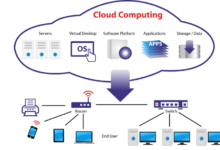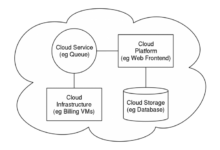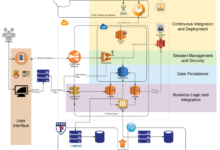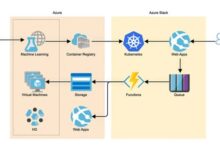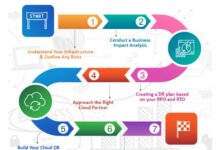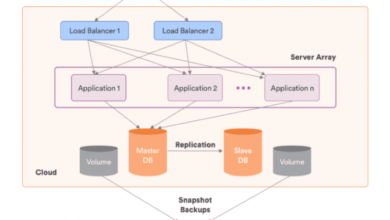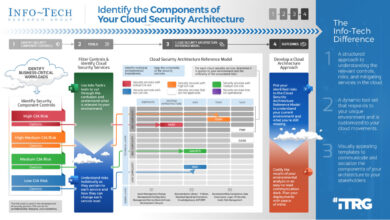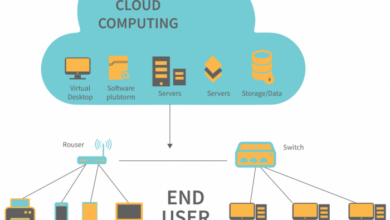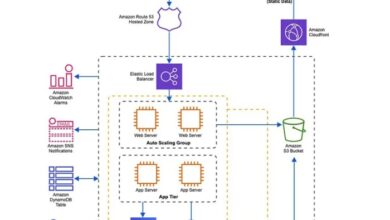Why Use a Cloud Architecture Diagram? Unraveling the Benefits and Applications
In the realm of cloud computing, a visual representation can often speak louder than words. Enter cloud architecture diagrams, the essential tools that provide a comprehensive blueprint for understanding, designing, and managing cloud-based systems. These diagrams serve as a common language, bridging the gap between technical experts and business stakeholders, and offer a wealth of benefits that make them indispensable in the modern era of cloud adoption.
Cloud architecture diagrams are not just mere illustrations; they are powerful communication tools that facilitate effective collaboration, identify potential pitfalls, and optimize cloud infrastructure. Dive into this comprehensive guide to uncover the myriad advantages of using cloud architecture diagrams and explore real-world examples that showcase their transformative impact across industries.
Benefits of Using Cloud Architecture Diagrams
Cloud architecture diagrams offer a visual representation of cloud infrastructure components and their relationships. These diagrams serve as a powerful tool for communication, understanding, and problem identification in cloud environments.
Visual Representation of Cloud Components
Cloud architecture diagrams provide a visual representation of the various components within a cloud infrastructure, including servers, storage, networking, and application components. This visual representation helps stakeholders understand the interconnections and dependencies between these components, facilitating a comprehensive understanding of the cloud architecture.
Improved Communication and Understanding
Cloud architecture diagrams enhance communication and understanding among stakeholders. By presenting a visual representation of the cloud architecture, these diagrams enable stakeholders from different backgrounds and expertise levels to grasp the overall design and relationships between components. This shared understanding promotes effective communication and collaboration during cloud infrastructure planning, deployment, and management.
Identification of Potential Issues and Bottlenecks
Cloud architecture diagrams aid in identifying potential issues and bottlenecks within the cloud infrastructure. By visualizing the components and their relationships, architects and engineers can analyze the architecture for potential points of failure, performance bottlenecks, and security vulnerabilities. This analysis helps in addressing these issues proactively, ensuring a reliable and efficient cloud infrastructure.
Common Components of Cloud Architecture Diagrams
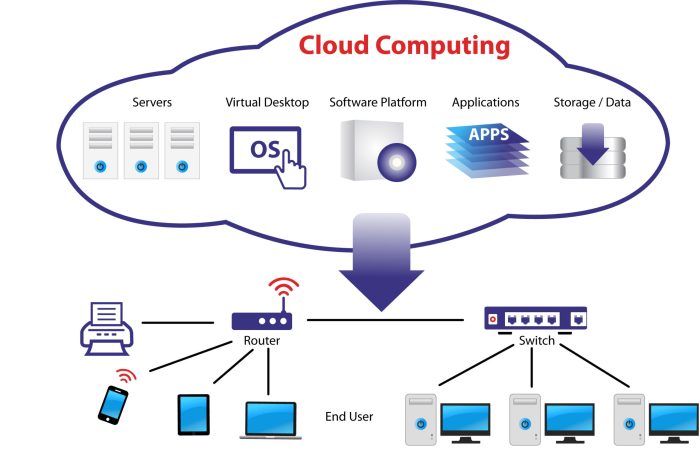
Cloud architecture diagrams are visual representations of the components and relationships within a cloud computing environment. They help stakeholders understand how cloud resources are organized and interconnected, and how they work together to deliver services.
Typically, cloud architecture diagrams include elements such as servers, storage, networks, and applications. These components are interconnected through a variety of protocols and technologies, such as TCP/IP, HTTP, and SSL. The diagrams also show the relationships between different cloud components, such as the relationship between a web server and a database server.
Deployment Models
Cloud architecture diagrams can also illustrate different cloud deployment models, such as public, private, and hybrid clouds. In a public cloud, resources are shared among multiple tenants, while in a private cloud, resources are dedicated to a single tenant. A hybrid cloud is a combination of public and private clouds, allowing organizations to take advantage of the benefits of both models.
Containers, Microservices, and Orchestration Tools
Cloud architecture diagrams can also show the role of containers, microservices, and orchestration tools in cloud architectures. Containers are lightweight, portable environments that can run applications in isolation. Microservices are small, independent services that can be combined to create larger applications.
Orchestration tools are used to manage and coordinate containers and microservices.
Design Principles for Effective Cloud Architecture Diagrams
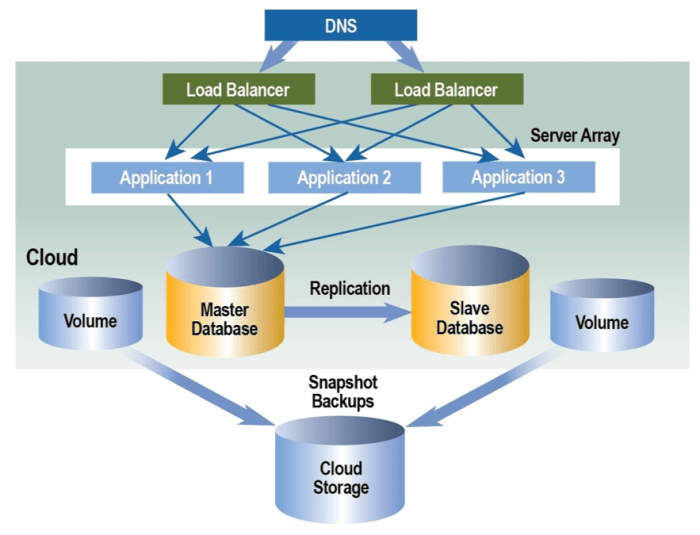
The effectiveness of a cloud architecture diagram depends heavily on its clarity, simplicity, and consistency. To achieve this, it is important to adhere to certain design principles that guide the selection of symbols, colors, layouts, and the overall organization of elements within the diagram.
When choosing symbols, strive for simplicity and recognizability. Avoid using overly complex or abstract symbols that might confuse the viewer. Consistency is key – ensure that the same symbol is used throughout the diagram to represent the same element or concept.
This consistency extends to colors as well – assign specific colors to different types of elements and maintain this color scheme throughout the diagram.
Layout and Organization
The layout and organization of elements within the cloud architecture diagram play a crucial role in its clarity and readability. Strive for a logical flow that guides the viewer’s attention from one element to the next, making it easy to understand the relationships and interactions between different components.
- Group related elements together and use arrows or lines to indicate connections or dependencies.
- Avoid cluttering the diagram with unnecessary details or excessive text. Focus on conveying the essential information in a concise and visually appealing manner.
- Ensure that the diagram is well-balanced and visually appealing. White space can be used effectively to create visual separation and improve readability.
Tools and Techniques for Creating Cloud Architecture Diagrams
Creating cloud architecture diagrams is a crucial aspect of cloud architecture planning and communication. Various software tools and techniques are available to assist in this process.
Popular Software Tools
Several popular software tools are specifically designed for creating cloud architecture diagrams. These tools offer a range of features and functionalities to help users create professional and visually appealing diagrams. Some of the most commonly used tools include:
- Lucidchart: A cloud-based diagramming tool with a user-friendly interface and extensive template library.
- draw.io: A free and open-source diagramming tool that runs in a web browser or as a desktop application.
- Visio: A Microsoft Office application that offers a wide range of diagramming capabilities and integration with other Office products.
Benefits of Cloud-Based Diagramming Tools
Cloud-based diagramming tools offer several benefits over traditional desktop applications, including:
- Collaboration: Multiple users can work on the same diagram simultaneously, facilitating real-time collaboration and feedback.
- Sharing: Diagrams can be easily shared with stakeholders and team members, enabling effective communication and feedback gathering.
- Version Control: Cloud-based tools often provide version control capabilities, allowing users to track changes and revert to previous versions if necessary.
Selecting the Right Tool
The choice of cloud architecture diagramming tool depends on specific needs and preferences. Factors to consider include:
- Features and Functionality: Assess the tool’s features and functionality to ensure it meets your specific requirements.
- Ease of Use: Consider the tool’s user-friendliness and learning curve to ensure it is accessible to all users.
- Collaboration and Sharing Capabilities: Evaluate the tool’s collaboration and sharing features to determine if it supports your team’s workflow.
- Cost: Consider the cost of the tool, including subscription fees, licensing, and any additional costs.
Sharing and Collaborating on Cloud Architecture Diagrams
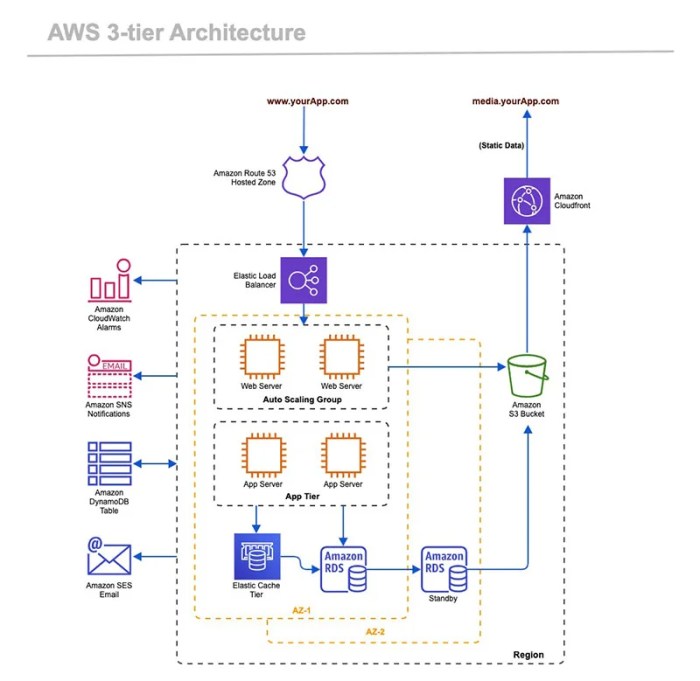
Sharing cloud architecture diagrams with stakeholders is crucial for gathering feedback, securing approvals, and fostering collaboration. Cloud-based diagramming tools facilitate real-time editing, version control, and seamless communication, enhancing teamwork and ensuring all stakeholders are on the same page.
Importance of Sharing Diagrams
- Feedback and Approvals: Sharing diagrams with stakeholders allows them to provide valuable feedback, identify potential issues, and suggest improvements, leading to better decision-making and project outcomes.
- Collaboration: Cloud-based diagramming tools enable multiple stakeholders to collaborate simultaneously, regardless of their location. This fosters teamwork, promotes knowledge sharing, and streamlines the design process.
- Documentation: Diagrams serve as visual documentation of the cloud architecture, making it easier for stakeholders to understand the system’s components, interactions, and dependencies. This documentation aids in onboarding new team members, troubleshooting issues, and ensuring compliance with regulations.
Benefits of Cloud-Based Diagramming Tools
- Real-time Editing: Cloud-based diagramming tools allow multiple users to edit diagrams simultaneously, enabling seamless collaboration and instant feedback.
- Version Control: These tools provide version control, allowing users to track changes, revert to previous versions, and maintain a history of the diagram’s evolution.
- Communication and Feedback: Cloud-based diagramming tools often include features for commenting, annotations, and discussions, facilitating effective communication and feedback among stakeholders.
Tips for Effective Communication and Documentation
- Use Clear and Consistent Symbols: Employ standardized symbols and notations to ensure clarity and consistency in the diagrams. This makes them easier to understand and interpret for all stakeholders.
- Provide Context and Annotations: Add context and annotations to explain the purpose, scope, and key aspects of the diagram. This helps stakeholders grasp the overall architecture and its components.
- Maintain a Consistent Style: Use a consistent style, including fonts, colors, and layout, to enhance the visual appeal and readability of the diagrams.
- Version Control and Documentation: Maintain proper version control and documentation of the diagrams, including the date of creation, author, and any significant changes. This aids in tracking changes, maintaining historical records, and ensuring accountability.
Use Cases and Examples of Cloud Architecture Diagrams
Cloud architecture diagrams serve as valuable tools in various industries, enabling stakeholders to visualize and comprehend complex cloud environments. These diagrams find application in diverse scenarios, including capacity planning, cost optimization, and security assessments.
Real-World Examples
Capacity Planning
Cloud architecture diagrams help IT teams anticipate and address future resource requirements by visually representing the current infrastructure and identifying potential bottlenecks. This enables proactive scaling to meet changing demands, ensuring optimal performance and avoiding disruptions.
Cost Optimization
By mapping out cloud resources and their associated costs, cloud architecture diagrams aid in identifying areas for cost savings. This facilitates informed decisions regarding resource allocation, service selection, and optimization strategies, leading to reduced operational expenses.
Security Assessments
Cloud architecture diagrams play a crucial role in security audits and risk assessments. By visualizing the network topology, security controls, and data flow, IT teams can identify vulnerabilities and implement appropriate security measures to mitigate risks and ensure compliance with industry standards and regulations.
Case Studies
E-commerce Platform
A leading e-commerce company used cloud architecture diagrams to optimize its infrastructure for handling peak traffic during sales events. The diagrams enabled the team to identify and address potential bottlenecks, ensuring seamless customer experiences and maximizing revenue opportunities.
Healthcare Provider
A healthcare provider leveraged cloud architecture diagrams to design a secure and scalable cloud-based patient records system. The diagrams facilitated collaboration among IT, security, and medical professionals, resulting in a robust and compliant solution that met patient privacy requirements.
Manufacturing Company
A manufacturing company utilized cloud architecture diagrams to integrate its on-premises systems with cloud-based applications. The diagrams helped streamline data exchange, improve operational efficiency, and gain real-time insights into production processes.
Advanced Topics in Cloud Architecture Diagrams
As cloud computing continues to evolve, so do the complexities of cloud architectures. This section delves into advanced concepts and emerging trends in cloud architecture diagramming.
Multi-Cloud and Hybrid Cloud Architectures
Organizations are increasingly adopting multi-cloud and hybrid cloud strategies to optimize performance, reduce costs, and enhance resilience. Multi-cloud architecture involves using multiple cloud platforms from different providers, while hybrid cloud architecture combines on-premises infrastructure with cloud services.
Representing multi-cloud and hybrid cloud architectures in diagrams requires careful consideration. Architects must clearly depict the interconnections between different cloud platforms and on-premises components. Color-coding, shapes, and annotations can be used to distinguish between different cloud providers and services.
Automation and Infrastructure as Code (IaC)
Automation and Infrastructure as Code (IaC) play crucial roles in modern cloud architectures. IaC involves defining and managing infrastructure using code, enabling rapid provisioning, configuration, and scaling of cloud resources.
In cloud architecture diagrams, automation and IaC can be represented through symbols or annotations that indicate automated processes, scripts, or IaC tools. This helps stakeholders understand how infrastructure is managed and provisioned dynamically.
Emerging Trends and Innovations
The field of cloud architecture diagramming is constantly evolving, driven by technological advancements and changing business needs. Some emerging trends and innovations include:
- Microservices and Service Mesh: Diagrams can depict the interactions between microservices and the service mesh infrastructure, highlighting communication patterns and dependencies.
- Serverless Architectures: Diagrams can illustrate the ephemeral nature of serverless functions and their integration with other cloud services.
- Edge Computing: Diagrams can show the distribution of workloads and data across edge devices and cloud platforms.
- Artificial Intelligence and Machine Learning: Diagrams can incorporate AI/ML components and their integration with cloud infrastructure.
Conclusion
Cloud architecture diagrams have emerged as invaluable assets in the world of cloud computing, enabling organizations to navigate the complexities of cloud infrastructure with clarity and precision. They serve as visual guides that enhance communication, streamline decision-making, and empower teams to optimize their cloud environments.
As cloud adoption continues to reshape industries, the role of cloud architecture diagrams will only grow in significance, providing a solid foundation for innovation and success in the digital age.
